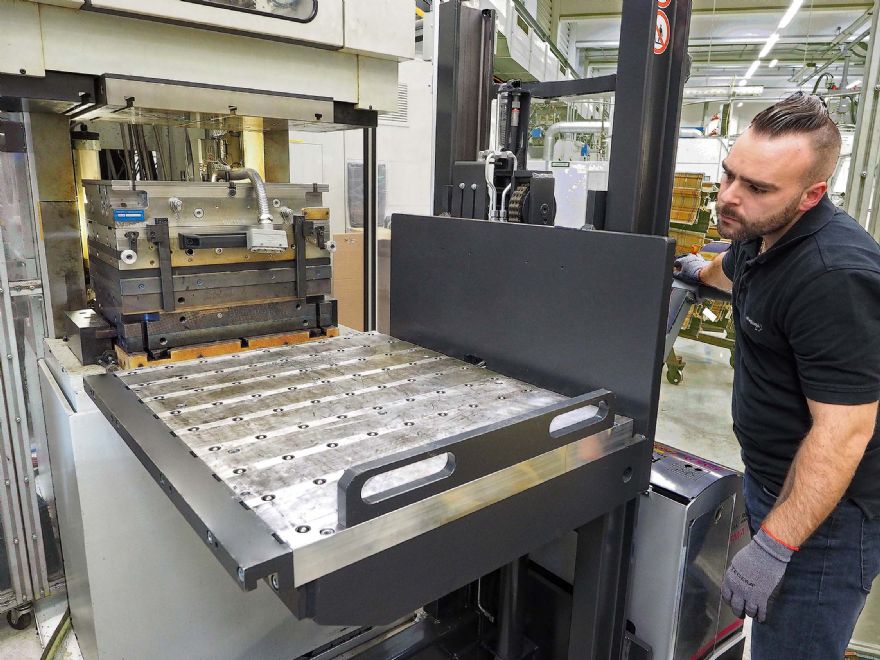 A mould about to be unloaded from the side of an injection moulding machine. The height of the cart table can be adjusted precisely
A mould about to be unloaded from the side of an injection moulding machine. The height of the cart table can be adjusted preciselyGermany-based vehicle components manufacturer
ElringKlinger, headquartered in Dettingen an der Erms, includes high-performance, lightweight plastic products such as oil pans and cam covers in the product portfolio it supplies to the global automotive industry.
Tobias Gerst, production engineer responsible for capital equipment procurement and process planning said: “Over the last few years we have grown steadily and are running out of space for our production equipment, so we are sometimes faced with very cramped conditions.”
Space is particularly limited where two automated injection moulding machines are operated over three shifts. They are located in an enclosure and mould exchange can only be carried out by entering a comparatively narrow, low door.
The two machines, which are positioned at an angle of about 120deg to each other, require a mould change every eight to nine days. As there is no overhead crane in the factory, the machines cannot be loaded from above. Instead, until recently operators used one of a number of standard transport carts.
Compact transport cartDirectly in front of one machine there is hardly any space for manoeuvring a cart, however, so previously mould change was challenging and physically exhausting. That has changed with the arrival of a compact transport cart supplied by German manufacturer, Roemheld in Hilchenbach, whose Surrey-based subsidiary
Roemheld UK Ltd supplies similar equipment into the UK market.

Mr Gerst added: “Our existing carts were either unsuitable for heavy moulds or too large for the limited space available. As a result we had to manoeuvre them in awkward spaces and still could not quite reach one of the machines.
"Therefore the machine had to be approached from the side instead, but this meant that the mould had to be pushed crosswise to roller bars on the changing cart. A lot of effort was required before the mould was finally in the right place."
So two years ago, he looked for an alternative that suited the special requirements better. The steel moulds used on the two machines weigh up to one tonne and have a maximum height of 400mm, while the base varies between 300 x 300mm and 550 x 500mm. The new changing cart had to be able to carry all moulds sizes and still fit through the enclosure’s narrow door.
Optimal accessHe was looking for a system where moulds could be transferred in different directions so that the operator could access both injection moulding machines optimally. One of them is located to the right of the enclosure entrance and the other is positioned opposite. The operator can drive in a straight line, load and unload the cart either from the right side or from the front and reverse out.
An internet search led Gerst to Roemheld's workholding and die changing technology. One of its carts, RWA 1600, is characterised by a compact design, an electro-hydraulic lifting platform and a shuttle table equipped with hydraulically actuated ball bars. The cart is also able to be customised to meet specific requirements.
With ball bars set into the support surface of the table, dies can easily be moved manually in any direction. A special safety mechanism ensures that during mould transportation the ball inserts are lowered into the table surface so the die is prevented from moving. Removable front and side bars provide additional safety.
As standard, Roemheld offers three versions of the 1,600kg-capacity cart with either four, six or eight ball bars. After detailed consultation, however, Gerst suggested to ElringKlinger a special version with nine bars. It ensures that even the smallest moulds used by the manufacturer are securely supported by at least two bars.
The engineer also opted for a smaller 850 x 750mm table, instead of the standard size of 1,150 x 800 mm. The former is sufficient to accommodate all the moulds used at ElringKlinger while at the same time allowing the operator to access the narrow passages without difficulty. The cart has also been adapted to suit the low door lintel by shortening its mast by 10cm to 190cm.
The speed of the cart can be continuously adjusted up to 5km/h. For tight spots there is a creep speed of 2km/h that can be selected by flicking a toggle switch. When braking, energy is recovered to save the battery. Besides the drive motor, the battery also powers the lifting platform's hydraulic system and the ball bars.
With a charge of 240Ah, the battery can power the cart for about three hours at maximum speed with a full load. The battery can then be fully charged within 12hr. If the cart has to continue operating immediately, a replacement battery can be inserted in a few easy steps.